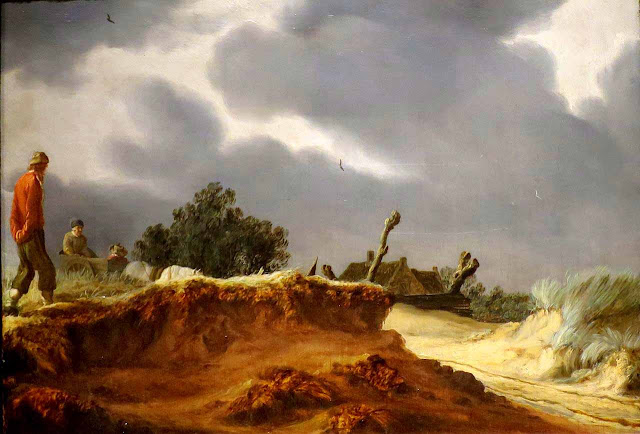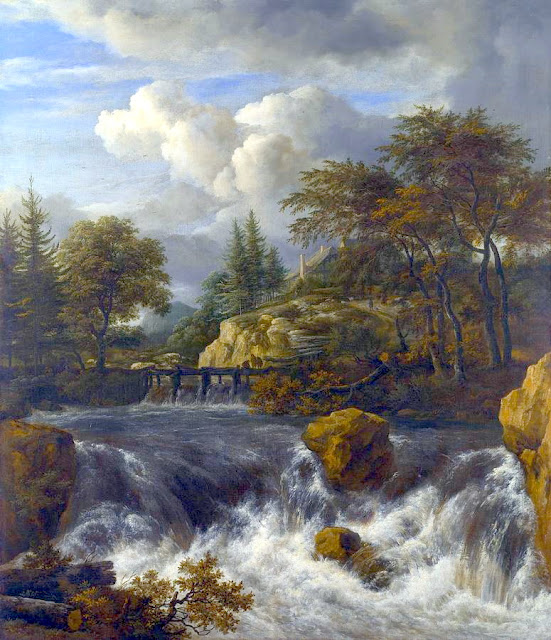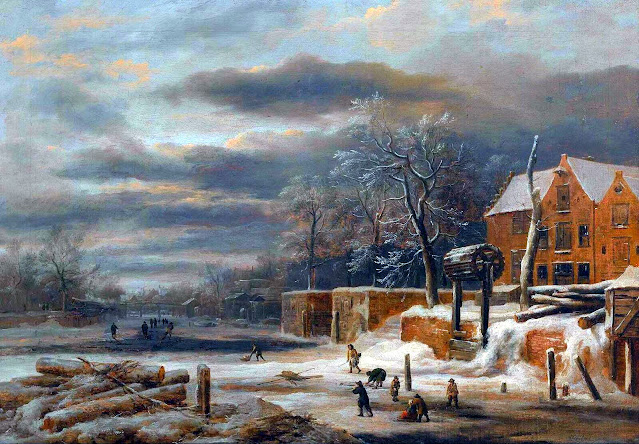Published: 1st Oct 2020
Jacob van Ruisdael was the outstanding landscape painter of the late seventeenth century. He was born into a family of painters working in Haarlem, which included Salomon van Ruysdael, one of the most talented landscapists of the previous generation. Salomon almost certainly trained Ruisdael, but the boy soon abandoned his uncle’s quiet restrained style in favour of a more dramatic and exuberant approach.
Ruisdael spent most of his career in Amsterdam where he found a ready market for his landscapes, and particularly for his exotic views of mountain scenery. The details of his life remain obscure but he seems to have been a pious and melancholy man with a poet’s talent for infusing his works with atmosphere and mood. He may also have practised as a surgeon in Amsterdam, although this remains unconfirmed.
Jacob van Ruisdael was born in Haarlem in about 1628 or 1629, the son of Isaac van Ruisdael and his second wife, Maycken Cornelisdr. There is no record of his birth, but in 1661 he declared in a legal document that he was 32. Apparently, he came from an artistic family. His father, though primarily a frame-maker and art dealer by trade, was also a minor painter and is known to have designed cartoons for tapestries. He painted a few landscapes, but none of them have survived. More importantly, Jacob’s uncle, Salomon van Ruysdael (the difference in spelling occurs in their signatures), was one of the most talented landscape painters of the early 17th century and a respected member of the Haarlem Guild of St. Luke.
Saloman van Ruysdael: Landscape with Sandy Road 1628
Jacob remained close to his uncle all his life, and Saloman likely gave him much of his early training.
The city of Haarlem was at the time the home of the Dutch school of landscape painting. Before the beginning of the 17th century, there had been little landscape painting as such in the Northern Provinces (the modern-day Netherlands). Only a few artists had painted independent landscapes, and they were mainly immigrants from Flanders. But in the two decades before Jacob’s birth, an outstanding generation of painters had developed a specifically Dutch type of landscape painting, a technique which became instantly successful. Jacob’s uncle was one of the guiding members of this group, together with Esaias van de Velde and Jan van Goyen.
These three artists lived in Haarlem at some point of their careers. Thus, as a child Jacob came into contact with some of the most influential painters of the day. His father seems to have had particularly close connections with Jan van Goyen, because in 1634 van Goyen was fined three guilders by the Haarlem Guild for painting pictures in Isaack’s house. Although he was staying in Haarlem, van Goyen was not a member of the Guild, and was thus barred from working in the town.
Few details are known of Ruisdael’s life, and the circumstances of his early training remain obscure. It seems likely that he trained initially with his uncle, although their styles remained highly distinct. Ruisdael was certainly exceptionally precocious, since his earliest works date from 1649, when he was at most 18, but they show no trace of immaturity. By this time he must have been a member of the Guild, since that was a condition of working independently in the city. He would have been unusually young for Guild membership, but he may have been given a concession on account of his obviously outstanding artistic talent.
Jacob van Ruisdael: The Large Forest 1850s
During his early years in Haarlem, Ruisdael travelled quite extensively, although he never went far afield. He clearly had a liking for picturesque places, and visited the scenic ruined church at Egmond van Zee, and the Portuguese Jewish cemetery at Ouderkerk.
During the 1650s he became more adventurous and explored the border region between the eastern provinces of the Netherlands and West Germany, travelling with his friend and collaborator Nicholas Berchem, who sometimes painted the figures in Ruisdael’s work.
Ruisdael remained in Haarlem until about 1656, devoting himself to his career and his family. Although he was by no means rich, he seems to have provided financial support for his father (who constantly had money problems) from his earliest years.
In about 1656 Ruisdael moved to Amsterdam. Like most Dutch painters of the time, he must have worked mainly for the open market. Consequently, little information is available about his patrons. His only known one was the wealthy Amsterdam town-councillor Cornelis de Graeff. In collaboration with the portraitist Thomas de Keyser, Ruisdael executed a painting of de Graeff and his family arriving at their country estate at Soestdijk.
In May of 1667, Ruisdael made two wills. The wills described him as 'a bachelor, sick in body, but in possession of his physical and mental faculties'. In fact, he lived for another 15 years, years which saw the production of some of his most original and inspired works. Around 1670, he took rooms on the south side of the Dam, above a shop kept by Hieronymous Sweerts, a book and art dealer. The two clearly enjoyed a good relationship, and Sweerts published a number of Ruisdael's etchings.
In 1681 Ruisdael’s cousin became insane. He was taken to the Almshouse in Haarlem, where he died towards the end of the year. For many years a confusion between the two men (who were almost exact contemporaries as well as near namesakes) led to the belief that Ruisdael himself died in penury. In fact he earned good money for his works until the end of his life. Ruisdael himself died in Amsterdam around the 10th of March 1682. He is buried in St Bavo’s , a magnificent Gothic church in Haarlem.
St Bavo's Church, Haarlem
Haarlem
Ruisdael was born in Haarlem in 1628 or 1629. The city was a thriving artistic and industrial centre, and had become exeptionaly prosperous through its linen-bleaching trade. Its success was a source of great civic pride.
Jacob van Ruisdael: The Castle of Edmond
Throughout his life, Ruisdael travelled in search of fresh artistic inspiration, although he never strayed far from home. In the 1650s he made an excursion to the castle of Edmond, near Alkmaar, and the ruins made a profound impression on him. He sketched and painted the castle from several different angles.
Jacob van Ruisdael: The Castle at Bentheim
In the early 1650s, Ruisdael visited the border region. The hilly wooded landscape must have made an exiting change from the flat countryside around Haarlem.
Thomas Gainsborough: Landscape with Sand Pit 1746
John Constable: Water-Mill at Gillingham 1824
Jacob van Ruisdael: The Jewish Cemetery (1)
Jacob van Ruisdael: The Jewish Cemetery (2)
In this version there is more light and colour. The rainbow, too, is more visible, emphasising the renewal of hope. The ruin is based on the Abbey at Egmont.
Jacob van Ruisdael: Jacob van Ruisdael: Vessels in a Breeze
About 30 seascapes are none as the work of Ruisdael, and they all testify to his preference for showing the dramatic aspects of nature, since not one of them features a calm sea. Usually – as here – the paintings are sombre in mood and capture with great intensity the feeling of a chilly and gusty day, with waves roughly breaking on the shore or on a breakwater, and the masts of small vessels leaning steeply in the wind.
Salomon van Ruysdael’s calm landscapes are typical of the Haarlem school of the early 17th century, and markedly different from Ruisdael’s florid, exuberant style.
Amsterdam
Meindert Hobbema: The Avenue at Middleharnis
Meindert Hobbema was Ruisdael’s close friend and his most gifted pupil. Hobbema’s most famous work, The Avenue at Middleharnis, shows his preference for sunny, rather prosaic settings. But his wonderful gift of composition made this one of the most memorable landscape paintings in the world of art.
Jacob van Ruisdael: Landscape with the Ruins of the Castle of Egmond (early 1650s)
Ruisdael's concern at the time of this painting was with elongated forms and solid masses. In depicting a ruin, he may have been making a comment on the durability of man's work. He was certainly not interested in accurate representations, since the hill here is imaginary.
This winter landscape of Ruisdael is utterly desolate, a winter to escape from, not to enjoy as in the winter skating scenes of other painters. The bleakness of winter is conveyed by Ruisdael's use of monochrome, and the only relief from darkness is the dirty white of the snow. The small size and upright format here is characteristic of Ruisdael's winter scenes, for a third of them have similar dimensions.
This was painted at the end of Ruisdael's career. The brooding stillness of this seashore setting is broken only by the rolling of the waves. The figures were contributed by Gerard van Battem, who added to the mood of the painting by keeping the figures small and muted.
A distinctive feature of Ruisdael's work is his detailed treatment of trees and foliage. This delicate sketch demonstrates Ruisdael's acute understanding of natural forms.
These houses are typical of those that Ruisdael would have seen during his travels around the West German border region. This drawing was likely done from memory after Ruisdael's return home. Dwellings of similar type appear in many of his works.
This drawing of the late 1650s reveals an exceptional delicacy of treatment. Ruisdael's talent for conveying light effects is particularly noticeable here, especially in his treatment of the river with its glassy surface and shimmering reflections.
Jacob van Ruisdael: Hilly Wooded Landscape with Cattle
At this time, Ruisdael became interested in compositional scheme of hills rising either side of a distant view. Here the geographical forms and mass of foliage are emphasised by being close up in the foreground, while the low sky gives the impression of distance
The herdsmen and the cattle are dominated by the landscape. Nevertheless, reflected light illuminates the two figures, drawing attention to them.
Moody Skies
Ruisdael wished to create an atmosphere in his landscapes and he accomplished this in his depiction of the sky and clouds. He never painted a cloudless sky, and while his range of moods was wide, his particular genius lay in the creation of dark, brooding skies, often suggesting an impending storm.
This painting is signed and dated by Ruisdael, and according to old sources it once also bore the signature (now no longer visible) of Ruisdael's friend Nicolaes Berchem, who painted the figures. This kind of collaboration was common in Dutch painting, particularly with 'staffage' - the term for small figures that are simply animating details.
Jacob van Ruisdael: A Sunlit Grain Field on the Banks of a Coast (early 1600s)
Ruisdael here makes striking use of one of his favourite pictorial devices - showing the sun breaking through heavy clouds to illuminate part of a scene brightly while other parts are in shadow. Here he conveys a vivid sense of the clouds scudding quickly overhead. The location of the painting has not been definitely identified but it is widely agreed that the sea in the background is the Zuider Zee.
It is possibly surprising that the windmill, which is the best known symbol of the Dutch landscape, should appear so rarely as the major theme in Ruisdael's paintings. But in this striking work he shows the strength and power of the windmill as it dominates the landscape. It is difficult to determine whether this painting has a symbolic meaning or not, but at the time people were keenly aware of their dependence on the natural forces of wind and water.
The Waterfall was a subject that Ruisdael made his own, and he had a certain fondness for Scandinavian torrents, even though he never visited that part of Europe. He began painting these subjects following his move to Amsterdam. Some of Ruisdael's Scandinavian scenes have a rather bleak, elemental quality, but here there is a fairly calm atmosphere, despite the foaming water.
Jacob van Ruisdael: Winter Landscape 1660s
The winter landscape has a long and eminent in the paintings of the Netherlands, but in this stark scene Ruisdael broke from the picturesque tradition of showing merry figures tobogganing and skating and painted the true feel feel of a bleak winter day, with its threatening clouds and forbidding atmosphere. Indeed, several critics have remarked upon the 'tragic' nature of the painting, with winter seen as symbolising sadness and even death.
Jacob van Ruisdael: A Winter Scene with a Village and a Frozen Canal
This winter landscape is bleak enough, too, but lightened by the site of the villagers, coming towards us instead of walking away. Their clothes show some trace of colour, while the dog frolicking at the head of the procession lends the scene some emotional warmth.
Another extremely bleak winter landscape. Again, the use of colour is extremely limited and the bridge across the canal isolates the village from the figures and the viewer. The flat perspective gives little sense of depth in the painting so that the villagers seem trapped in this heavy winter atmosphere and their preoccupation with logs is a reminder that they must work just to keep warm at home.
The ramshackle house has anything but a welcoming aspect and it is isolated from the town by distance and two canals. Pride of place in the painting is given to two dead trees, so that the painting has the look of living death. The sky is lively and bright enough but it is threatened by dark clouds that seem to emanate from this creepy house.
Jacob van Ruisdael: Winter Landscape 1660s
Again, the painting is dominated by dark clouds and the human figures are remote and colourless. There is an impressive windmill but it, like the figures, is turned away from the viewer in a brooding manor.
Jacob van Ruisdale: Winter Landscape c1670
Dark clouds, much of the landscape black, and remote motionless figures. A tree that seems to grasp like a hand, suggesting the clutch of the winter's cold.
Jacob van Ruisdael: Winter Landscape with Two Windmills 1675
Dramatic and stirring effects can be created in winter by the occurrence of Hoarfrost, shown here in the trees, and by the unblemished stretches of new-fallen snow.
Jacob van Ruisdael: Landscape with a Watermill (after 1660s)
The mood of the painting is governed by the dark clouds overhead, and the colourless couple of human figures are almost indistinguishable from the landscape. The three logs scattered on the left edge convey a sense of the disorder and futility that grasps human life in extreme cold weather.
1628/29-1682














































No comments:
Post a Comment